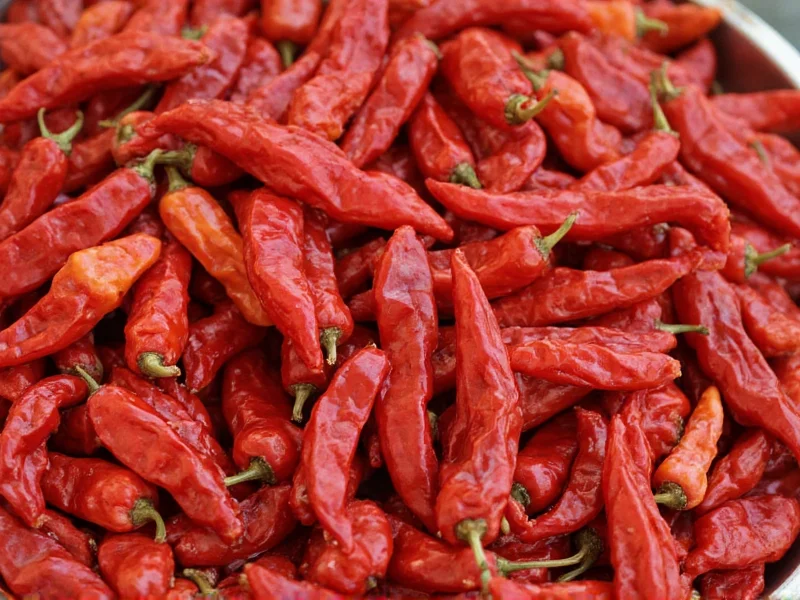Dried peppers transform ordinary dishes into extraordinary culinary experiences through their concentrated flavors and extended shelf life. Unlike fresh peppers that spoil quickly, properly stored dried peppers maintain their potency for up to a year, providing home cooks and professional chefs with reliable access to diverse heat levels and flavor notes. The drying process intensifies natural sugars while developing complex smoky or earthy undertones depending on the variety and drying method.
Essential Culinary Applications of Dried Peppers
Understanding how to use dried peppers effectively requires knowledge of their specific characteristics. The most valuable dried pepper varieties each contribute distinctive qualities to dishes:
| Dried Pepper Variety | Heat Level (Scoville) | Flavor Profile | Best Culinary Uses |
|---|---|---|---|
| Ancho (dried poblano) | 1,000-2,000 | Fruity, raisin-like, mild earthiness | Moles, enchilada sauces, stews |
| Guajillo | 2,500-5,000 | Berry-like, tea notes, moderate heat | Adobos, marinades, salsas |
| Chipotle (smoked jalapeño) | 2,500-8,000 | Smoky, tobacco, medium heat | Barbecue sauces, bean dishes, braises |
| Arbol | 15,000-30,000 | Sharp, nutty, intense heat | Salsas, vinegar infusions, finishing spice |
| Thai Bird's Eye | 50,000-100,000 | Citrusy, floral, extreme heat | Curries, stir-fries, dipping sauces |
Mastering Dried Pepper Preparation Techniques
Proper preparation unlocks the full potential of dried peppers. The rehydration process significantly impacts final flavor and texture in dishes. For most applications, toast whole dried peppers in a dry skillet for 30-60 seconds until fragrant but not burnt, then submerge in hot water for 15-20 minutes. This how to rehydrate dried peppers for cooking method plumps the peppers while preserving volatile flavor compounds that boiling would destroy.
When creating homemade hot sauce with dried peppers, combine rehydrated peppers with vinegar, garlic, and spices in a blender. For smoother sauces, strain through a fine mesh sieve. Different vinegar types dramatically alter the final product—rice vinegar creates milder Asian-inspired sauces while apple cider vinegar yields complex fermented notes.
Advanced Applications for Dried Peppers
Chefs utilize dried peppers in sophisticated applications beyond basic seasoning. Creating infused oils using dried chili peppers requires careful temperature control—heat oil to 160°F (71°C) with peppers for 20 minutes, then strain. Never leave peppers in oil at room temperature due to botulism risk.
For baking applications, finely ground ancho or pasilla powder adds subtle warmth to chocolate desserts. The Maillard reaction between pepper compounds and sugars creates unexpected depth in brownies and spice cakes. When substituting dried peppers for fresh in recipes, use a 1:3 ratio by weight (1 ounce dried ≈ 3 ounces fresh) accounting for moisture loss during drying.
Storage Methods for Maximum Longevity
Preserve dried pepper quality through proper storage. Keep whole dried peppers in airtight containers away from light and heat. Vacuum sealing with oxygen absorbers extends shelf life to 18 months while maintaining volatile oils responsible for flavor. For long term storage of dried chili peppers, freeze in single-use portions—thaw only what you need to prevent moisture absorption.
Ground pepper powders lose potency faster than whole peppers. Create small batches of freshly ground dried pepper spice blends as needed rather than storing pre-ground mixes. Adding a whole clove of garlic to storage containers helps absorb excess moisture that degrades quality.
Global Culinary Traditions Featuring Dried Peppers
Dried peppers form the backbone of numerous international cuisines. In Mexican cooking, complex moles combine multiple dried varieties like mulato, ancho, and pasilla. Korean cuisine relies on gochugaru (dried red pepper flakes) for kimchi and stews. Ethiopian berbere spice blend features dried African bird's eye peppers alongside fenugreek and ginger.
Understanding regional applications helps recreate authentic dishes. The traditional uses of dried peppers in Mexican cuisine often involve toasting before rehydration to enhance smoky notes, while Southeast Asian preparations frequently use raw dried peppers in spice pastes. These cultural techniques developed over centuries optimize flavor extraction from available ingredients.
Practical Tips for Home Cooks
Beginners should start with milder varieties like ancho or guajillo before progressing to hotter options. Always wear gloves when handling extremely hot dried peppers like habaneros or ghost peppers—capsaicin concentrates during drying and can cause skin irritation. Never rub your eyes after handling dried peppers.
For easy ways to use dried peppers in everyday cooking, try adding a whole guajillo to tomato sauce for depth, blending arbol into mayonnaise for spicy aioli, or steeping chipotle in braising liquid for meats. A single dried pepper can transform simple dishes like roasted vegetables or grain bowls with minimal effort.











 浙公网安备
33010002000092号
浙公网安备
33010002000092号 浙B2-20120091-4
浙B2-20120091-4